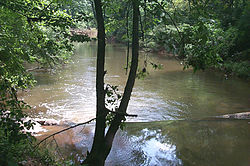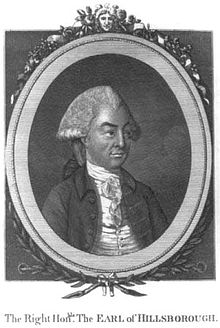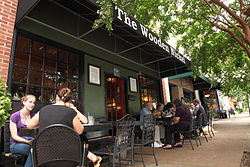- Hillsborough, North Carolina
-
Hillsborough, North Carolina — Town — The Eno River at Hillsborough Location of Hillsborough, North Carolina Coordinates: 36°04′14″N 79°06′15″W / 36.07056°N 79.10417°WCoordinates: 36°04′14″N 79°06′15″W / 36.07056°N 79.10417°W Country United States State North Carolina County Orange Area – Total 4.6 sq mi (11.9 km2) – Land 4.6 sq mi (11.9 km2) Population (2008) – Total 5,653 – Density 1,188.7/sq mi (459.1/km2) Time zone Eastern (EST) (UTC-5) – Summer (DST) EDT (UTC-4) ZIP code 27278 Area code(s) 919 Website www.ci.hillsborough.nc.us Hillsborough is a town in Orange County, North Carolina, United States. The population was 5,653 at the 2008 census. It is the county seat of Orange County.[1]
Its name was unofficially shortened to "Hillsboro" over the years (beginning in the 19th century) but was changed back to its original spelling in the late 1960s.
Contents
History
Native-American history
Local Native-American groups had lived in the Hillsborough area for thousands of years by the time European-American settlers discovered the area. Siouan-language groups such as the Occaneechi and the Eno were living in the Hillsborough area at the time of European contact, before they were displaced. The explorer John Lawson recorded visiting "Occaneechi Town" when he travelled through North Carolina in 1701.
In the early 18th century, the Occaneechi left Hillsborough for Virginia, returning to the area around 1780.[2] An original Occaneechi farming village was excavated by an archaeological team from UNC-Chapel Hill in the 1980s.[2] A replica of an Occaneechi village stands close to the original Eno River settlement.[2]
Colonial period and Revolutionary War
 An early map of the town produced in 1768 by Claude J. Sauthier.
An early map of the town produced in 1768 by Claude J. Sauthier.
Hillsborough was founded in 1754, and was first owned, surveyed, and mapped by William Churton (a surveyor for Earl Granville). Originally to be named Orange, it was named Corbin Town (for Francis Corbin, a member of the governor's council and one of Granville's land agents), and renamed Childsburgh (in honor of Thomas Child, the attorney general for North Carolina from 1751–1760 and another one of Granville's land agents) in 1759. It was not until 1766 that it was named Hillsborough, after the Earl of Hillsborough, the British secretary of state for the colonies and a relative of royal Governor William Tryon.
Hillsborough was an early Piedmont colonial town where court was held, and was the scene of some pre-Revolutionary War tensions. In the late 1760s, tensions between (in a nutshell) Piedmont farmers and county officers welled up in the Regulator movement, which had its epicenter in Hillsborough.[3] With specie scarce, many inland farmers found themselves unable to pay their taxes and resented the consequent seizure of their property. Local sheriffs sometimes kept taxes for their own gain and sometimes charged twice for the same tax. Governor William Tryon's conspicuous consumption in the construction of a new governor's mansion at New Bern fuelled the movement's resentment. As the western districts were under-represented in the colonial legislature, it was difficult for the farmers to obtain redress by legislative means. Ultimately, the frustrated farmers took to arms and closed the court in Hillsborough, dragging those they saw as corrupt officials through the streets.[3] Tryon and North Carolina militia troops marched to the region and defeated the Regulators at the Battle of Alamance in May 1771.[3] Several trials were held after the war, resulting in the hanging of six Regulators at Hillsborough on June 19, 1771.
The town was used as the home of the North Carolina state legislature during the American Revolution.[4] Hillsborough served as a military base for British General Charles Cornwallis in late February 1781. The United States Constitution drafted in 1787 was controversial in North Carolina. Delegate meetings at Hillsborough in July 1788 initially voted to reject, following Anti-Federalist views. They were persuaded to change their minds partly by the strenuous efforts of James Iredell and William Richardson Davie and partly by the prospect of a Bill of Rights. The Constitution was later ratified by North Carolina at a convention in Fayetteville.
William Hooper, a signer of the Declaration of Independence, was buried in the Presbyterian Church cemetery in October 1790. However, his remains were later reinterred at Guilford Court House Military Battlefield. His original gravestone remains in the town cemetery.
The Antebellum Period and American Civil War
The Burwell family ran a girl's academy called the Burwell School from 1837 to 1857 in their home on Churton Street. Elizabeth Keckley was enslaved in the Burwell household as a teenager. She later became the dressmaker and confidant of Mary Todd Lincoln and wrote a memoir.
When the Civil War began, Hillsborough was reluctant to support secession. However, many citizens went off to fight for the Confederacy.
In March 1865, Confederate General Joseph E. Johnston wintered just outside of Hillsborough at the Dickson home, which now serves as the Hillsborough Welcome Center in downtown (the house was moved from its original site in the early 1980s due to commercial development). The main portion of the Confederate Army of Tennessee was encamped around Greensboro.
After his March to the Sea, while camped in Raleigh, Union General William T. Sherman offered an armistice to Johnston, who agreed to meet to discuss terms of surrender. Johnston, traveling east from Hillsborough and Sherman, traveling west from Raleigh along the Hillsborough-Raleigh Road, met approximately half-way near present-day Durham (then Durham Station) at the home of James and Nancy Bennett, a farmhouse now known as Bennett Place. The two generals met three times on April 17, 18th, and finally on the 26th, which resulted in the final terms of surrender. Johnston surrendered 89,270 Southern troops who were still active in North Carolina, South Carolina, Georgia, and Florida. This was the largest surrender of troops during the war, and effectively ended the Civil War.[4]
Auto racing
Occoneechee Speedway, just outside Hillsborough, was one of the first two NASCAR tracks to open and is the only track remaining from that inaugural 1949 season. The Historic Occoneechee Speedway Trail (HOST), is a three-mile (5 km) trail located on 44 acres (180,000 m2) at the site of the former Speedway. Bill France and the early founders of NASCAR bought land to build a one-mile (1.6 km) oval track at Hillsborough, but opposition from local religious leaders prevented the track from being built in the town and NASCAR officials built the large speedway Talladega Superspeedway in Talladega, Alabama instead.[5]
Geography
Hillsborough is located at 36°4′29″N 79°6′15″W / 36.07472°N 79.10417°W (36.074794, -79.104183),[6] along the Eno River.
According to the United States Census Bureau, the town has a total area of 4.6 square miles (12 km2), of which, 4.6 square miles (12 km2) of it is land and 0.22% is water.
Demographics
As of the census[7] of 2000, there were 5,446 people, 2,101 households, and 1,428 families residing in the town. The population density was 1,188.7 people per square mile (459.1/km²). There were 2,329 housing units at an average density of 508.3 per square mile (196.3/km²). The racial makeup of the town was 60.26% White, 34.83% African American, 0.51% Native American, 0.57% Asian, 1.62% from other races, and 2.20% from two or more races. Hispanic or Latino of any race were 2.79% of the population.
There were 2,101 households out of which 34.9% had children under the age of 18 living with them, 42.9% were married couples living together, 20.9% had a female householder with no husband present, and 32.0% were non-families. 26.2% of all households were made up of individuals and 9.6% had someone living alone who was 65 years of age or older. The average household size was 2.48 and the average family size was 2.99.
In the town the population was spread out with 26.2% under the age of 18, 7.2% from 18 to 24, 32.7% from 25 to 44, 21.1% from 45 to 64, and 12.8% who were 65 years of age or older. The median age was 36 years. For every 100 females there were 86.3 males. For every 100 females age 18 and over, there were 81.0 males.
The median income for a household in the town was $40,111, and the median income for a family was $46,793. Males had a median income of $36,636 versus $29,052 for females. The per capita income for the town was $21,818. About 11.0% of families and 12.6% of the population were below the poverty line, including 16.1% of those under age 18 and 16.6% of those age 65 or over.
Notable Hillsboroughans
For its size, Hillsborough has a high concentration of residents who are nationally known authors, including Lee Smith, Allan Gurganus, Michael Malone, Annie Dillard, Hal Crowther, Jamie Gorski, Frances Mayes, the late Doug Marlette, and David Payne.[8]
- George B. Anderson - Civil War Confederate general, killed at the Battle of Antietam
- Logan Pause - Soccer player
- Doug Marlette - cartoonist and author, maintained a home in Hillsborough and was buried there[9]
- Lee Smith - Author
- Allan Gurganus, author of Oldest Living Confederate Widow Tells All
- William Hooper - A lawyer and politician who signed the United States Declaration of Independence for North Carolina
- Shepperd Strudwick - Actor
- Jamie Gorski - Playwright
- Sarah Hoyt - Author
- Frances Mayes - Author
- Connie Ray - Actress, The Torkelsons
- Elizabeth Keckly - Dressmaker and confidante of Mary Todd Lincoln and enslaved in the Burwell Household
- Billy Strayhorn - An American composer, pianist and arranger
- Annie Dillard - Author
- Michael Malone- Edgar Award-winning novelist and Daytime Emmy Award-winning soap opera writer
- Carmine Prioli - Author
- Anna Jean Mayhew - Author of The Dry Grass of August
- John Claude Bemis - Author of The Nine Pound Hammer
References
- ^ "Find a County". National Association of Counties. http://www.naco.org/Counties/Pages/FindACounty.aspx. Retrieved 2011-06-07.
- ^ a b c "Occaneechi Band of the Saponi Nation". Southern Neighbor. November 2009.
- ^ a b c Bishir, Catherine (2005). North Carolina Architecture. UNC Press. pp. 55–56. http://books.google.com/books?id=NccTgQkmPIEC&client=opera.
- ^ a b "Minding the museum". Chapel Hill News. July 25, 2007. Archived from the original on 2007-09-29. http://web.archive.org/web/20070929040755/http://www.chapelhillnews.com/weekend/story/8656.html. Retrieved 2007-07-30.
- ^ "Racing vs. Religion". Historic Hillsborough. Archived from the original on 2007-10-08. http://web.archive.org/web/20071008210038/http://www.historichillsborough.org/images/Speedway-Complete.pdf. Retrieved 2007-07-16.
- ^ "US Gazetteer files: 2010, 2000, and 1990". United States Census Bureau. 2011-02-12. http://www.census.gov/geo/www/gazetteer/gazette.html. Retrieved 2011-04-23.
- ^ "American FactFinder". United States Census Bureau. http://factfinder.census.gov. Retrieved 2008-01-31.
- ^ "Hillsborough Writers". Dee Gee's Books. 2008-07-27. http://www.deegees.com/staff-picks/cathy/51-hillsborough-writers. Retrieved 2009-09-13.[dead link]
- ^ "Cartoonist Doug Marlette dies in wreck". Raleigh News and Observer. Archived from the original on 2007-07-13. http://web.archive.org/web/20070713131622/http://www.newsobserver.com/105/story/632517.html. Retrieved 2007-07-16.
External links
- Hillsborough/Orange Chamber of Commerce
- OurHillsborough.com Online community forum
- Hillsborough Arts Council Hillsborough Arts Council
- Orange County Schools Orange County Schools
- Squeeze the Pulp Internet forum on politics, news, and community in Orange County
- OrangePolitics progressive multi-author blog about Orange County issues
- Hillsborough, North Carolina travel guide from Wikitravel
Hillsborough History
- The Alliance for Historic Hillsborough
- The Burwell School Historic Site
- Cameron Park Elementary School, Hillsborough, NC History
- Orange County historic information cache
- The Colonial Inn
Municipalities and communities of Orange County, North Carolina County seat: HillsboroughCities Towns Carrboro | Chapel Hill‡ | Hillsborough
Unincorporated
communitiesBlackwood | Buckhorn | Caldwell | Calvander | Carr | Cedar Grove | Dogwood Acres | Efland | Eno | Eubanks | Hurdle Mills | McDade | Miles | Oaks | Rougemont | Schley | Teer | University
Footnotes ‡This populated place also has portions in an adjacent county or counties
Greater Durham-Chapel Hill Metropolitan Region (Durham MSA) Principal cities 
Other significant cities Counties Major universities Transportation Raleigh-Durham International Airport • I-40 • I-85 • I-540 • US 15-501 • US 64 • US 70 • NC 147 • NC 54Media The Herald-Sun • The Daily Tar Heel • Independent Weekly • The News & Observer • Carrboro Citizen • The Courier TimesMiscellaneous Categories:- Populated places in Orange County, North Carolina
- Towns in North Carolina
- County seats in North Carolina
- Populated places established in 1754
Wikimedia Foundation. 2010.





